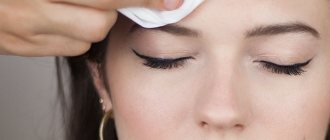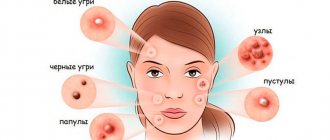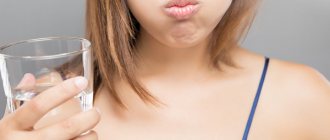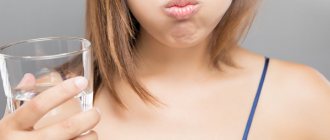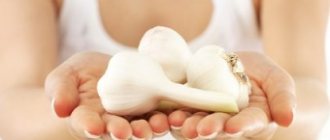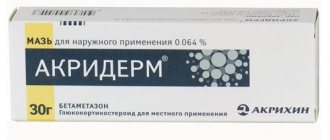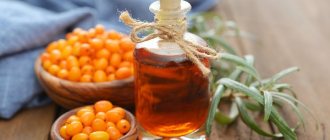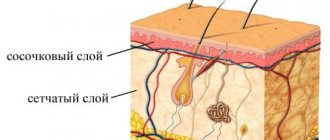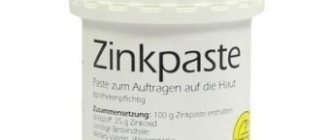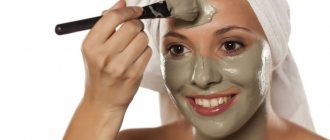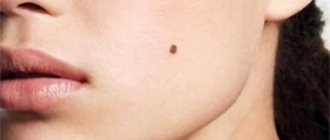Definition of drug
Miramistin is a broad-spectrum antiseptic medicine used in medicine and cosmetology, as well as for the disinfection of medical instruments and devices. It relieves swelling and inflammation, kills fungi and microbes, and accelerates tissue healing. It is often used as a preventive medicine against infections of various natures. In addition, when used to treat skin, Miramistin has the following effects on the skin:
- reduces redness;
- cleanses pores;
- stabilizes the functioning of the sebaceous glands.
Thus, Miramistin can replace lotions and ointments against acne and acne. However, uncontrolled use of the drug can cause addiction and side effects. Also find out how Adaklin works for acne here.
Seborrheic dermatitis. Terminology
Seborrheic dermatitis
- a chronic inflammatory skin disease associated with an increase in the quantity and change in the quality of sebum, as well as with the influence of skin microflora.
The composition of sebum includes glycerides (more than 40%), free fatty acids (16%), wax esters (up to 25%) and cholesterol, squalene (12%) and cholesterol. Triglycerides in sebum are broken down into free fatty acids by bacteria. Some of them form volatile fatty acids that impart odor to the skin. Sebum itself has no odor.
The wide prevalence and constant increase in incidence determines various approaches to treatment, the main goal of which is to achieve a long-term positive result.
Manifestation of seborrheic dermatitis:
1) thickening of the stratum corneum, peeling;
2) oily sheen, seborrhea, sebostasis (stagnation of sebaceous secretion at the mouth of the hair follicle);
3) inflammation of the skin;
4) itching.
Seborrheic dermatitis affects those areas of the scalp and body where the sebaceous glands are most developed:
- scalp,
- anterior chest area and interscapular area,
- area of the ears,
- forehead,
- nasolabial triangle.
When the skin of the scalp is affected, thinning and thinning of the hair is observed. In severe cases, seborrheic dermatitis can have the character of a widespread exfoliative process up to erythroderma.
| Dandruff = seborrheic dermatitis | Brightness of blood vessels - inflammation |
Composition and release form
Miramistin today is available in three forms:
- spray;
- ointment;
- solution.
The main active component of any of the compositions is benzyldimethyl-myristoylamino-propylammonium chloride monohydrate. In cosmetology practice, spray and ointment are most often used. It is also worth finding out whether Baziron cream helps against acne in the article.
For cosmetic purposes, you can also use a regular solution of the drug. However, the quality of treatment with its help will be less pronounced, since the concentration of the active substance in it is only 0.01%, and in the spray it is 0.5%.
Application area
Miramistin actively fights most gram-positive and gram-negative bacteria, including hospital bacteria. The drug destroys yeast and yeast-like fungi and dermatophytes, viruses (including sexually transmitted ones). Thanks to these properties, it is effective in surgery, dermatology and venereology, dentistry, otolaryngology, urology and gynecological practice. Find out what Akriderm cream helps with here.
Indications
Indications for use in cosmetology are the following pathologies:
- acne (acne);
- prevention of inflammation after cosmetic procedures;
- traumatic skin injuries;
- acne, suppuration;
- microbial infections;
- enlarged clogged pores;
- excessively active production of sebum;
- candidomycosis;
- herpes;
- burn injuries.
Thus, it is possible to use Miramistin directly to treat skin problems on the face and body, provided the dosages are observed.
Contraindications
Sprays and solutions should not be used by persons who are hypersensitive to the composition of the drug. In addition, these drugs are prohibited for use in children under three years of age.
The ointment should also not be used if there is a high probability of allergies. In this form, the drug is prohibited for children under one year of age. There is no data on use during pregnancy and breastfeeding, however, in this case, treating the skin with Miramistin is allowed. You can learn about the effect of Metrogyl gel against acne in this material.
How to use Miramistin
The use of Miramistin as an antiseptic drug is quite widespread. In addition to the areas listed in the table below, the medicine is prescribed for the treatment of acne, as a prevention of influenza and colds, and for diaper rash.
How to use Miramistin correctly
Please note that Miramistin may cause irritation of the nasal mucosa.
Any prescription of the drug, indication of the dosage and duration of the course are made by the attending physician.
| Disease | Course duration | Reception |
| Purulent sinusitis. Tonsillitis, pharyngitis and laryngitis. | From 4 to 10 days. | The maxillary sinus is washed with a sufficient amount of the drug. Gargling and/or irrigation (10-15 ml) 3-4 times a day is indicated. |
| Stomatitis, gingivitis, periodontitis. | Until remission occurs. | Rinse the mouth with 10-15 ml of the drug, 3-4 times a day. |
| Surgery, traumatology, combustiology. | 3-5 days. | 2-3 times/day. irrigate the surface of wounds and burns, loosely pack wounds and fistula tracts, fix gauze swabs soaked in the drug. |
| Prevention of postpartum infection. C-section. | 5-7 days. 7 days. | Irrigation with a gynecological nozzle is indicated before childbirth, during childbirth, after each vaginal examination and in the postpartum period, 50 ml of the drug in the form of a tampon (2 hours). Before the operation, the vagina is treated, during the operation - the uterine cavity and the incision on it, and in the postoperative period, tampons moistened with the drug are inserted into the vagina (2 hours). |
| Angina. | Until remission occurs. | Rinse 4-5 times/day. |
| Urethritis and urethroprostatitis. | 10 days. | Miramistin is injected using a urological applicator into the urethra 2-3 ml 1-2 times a day. |
| Prevention of sexually transmitted diseases. | Miramistin is used no later than 2 hours after sexual intercourse. | Using a urological applicator (gynecological attachment), insert Miramistin into the urethra for 2-3 minutes: for men (2-3 ml), for women (1-2 ml) and in the vagina (5-10 ml). Treat the skin of the inner thighs, pubis, and genitals. After the procedure, it is recommended not to urinate for 2 hours. |
| Thrush, inflammatory diseases of the genital organs. | 7-14 days. | A tampon is moistened with Miramistin and inserted intravaginally. Douching is indicated. |
| Purulent otitis. | Until remission occurs. | 2 ml of solution is injected into the external auditory canal. |
Miramistin during pregnancy and lactation
Miramistin can be used by pregnant women and nursing mothers, but, as is usually the case with this group of patients, use is possible after consulting the doctor supervising them. They can be used to gargle, rinse the nose and treat affected surfaces, since Miramistin does not enter the bloodstream. But in any case, an obstetrician-gynecologist should prescribe the drug during pregnancy and breastfeeding.
Miramistin for children
Miramistin for children
If we touch on the issue of using Miramistin in pediatrics, the drug can be prescribed by a doctor for children during an exacerbation of pharyngitis or during the exacerbation stage of chronic tonsillitis. If such conditions are diagnosed, then most likely the pediatrician will prescribe irrigation of the child’s throat with Miramistin.
- children 3-6 years old: press the head of the spray nozzle once (3-5 ml per irrigation), 3-4 times/day;
- children 7-14 years old: press twice (5-7 ml per irrigation), 3-4 times/day;
- children over 14 years old: 3-4 times pressing (10-15 ml per irrigation), 3-4 times/day.
As for the nose, care should be taken here, since Miramistin can have an irritating effect on the mucous membrane. Also, Miramistin is prescribed to young patients if they have chickenpox. The skin is treated with Miramistin in order to disinfect it. If the drug is prescribed to an infant, it is most likely for the treatment of surfaces that require disinfection. Miramistin, due to its composition, accelerates the regeneration of the epithelium. After the drug has dried naturally, you can use diaper rash cream or a special powder containing talc.
The instructions for use stipulate the age of the child from which the use of Miramistin is permissible. Thus, children under one year of age undergo therapy with Miramistin only under the supervision of a specialist; children up to three years of age can be prescribed the drug solely for indications. Remember that children's bodies are sensitive, and even such a safe drug as Miramistin can cause allergic reactions.
Analogs
Analogs
At the moment, one structural analogue of the drug Miramistin has been released on the pharmacological market:
- Okomistin (eye drops).
If you do not take into account the composition, then in terms of therapeutic action the antiseptic Chlorhexidine is closest to the drug Miramistin. You can also note Octenisept.
Miramistin or Chlorhexidine?
Most often, when they talk about replacing the drug Miramistin, Chlorhexidine is cited as an example. What is the significant difference between these drugs? If you focus on the indications for use, they are almost identical. True, it is believed that Chlorhexidine has more side effects and is generally toxic. But this disadvantage has a downside. This “aggressiveness” is directed against microbes. Miramistin is a more gentle remedy, it is safe, so it is prescribed for the treatment even of infants. The drug Miramistin does not monitor negative reactions of the body to its use; it is less likely to cause a burning sensation and unpleasant consequences in the form of dysbacteriosis.
Benefits and harms
Miramistin in the form of a spray and ointment provides invaluable benefits to the skin:
- kills many types of common bacteria;
- increases the body's resistance and level of immunity;
- stimulates skin cell regeneration.
In addition, the drug rarely causes allergies, and in addition, it can reduce the resistance of pathogens to antibiotics and other bactericidal agents.
Meanwhile, when using it, it is necessary to take into account possible side effects. If the dosage is not followed correctly and long-term use, dryness and flaking of the skin and mucous membranes may occur.
It is useful to keep Miramistin in the first aid kit, since it can be used to treat abrasions, burns, cuts and other skin injuries. It leaves no marks and promotes rapid healing.
If the skin is hypersensitive, Miramistin can be diluted with a small amount of clean water to reduce the likelihood of side effects.
Is it possible to gargle with Miramistin?
For throat diseases, it is necessary to treat it with Miramistin. You can simply spray it on your throat, or you can gargle it. For an adult, there is no need to dilute the drug with water. And for children you can dilute it half and half with water.
You should rinse after eating, having previously cleaned your mouth. Ten milliliters of product is enough for one procedure. You need to rinse for five minutes, pronouncing the sound “s”.
It is important to ensure that the child does not swallow the product. If an adult or child accidentally swallows Miramistin, then there may be nausea or an allergic reaction. If the remedy has already been used before and there was no allergy, then swallowing the remedy can only cause nausea.
The procedure must be repeated at least five times a day. You can alternate rinsing with Miromistin with conventional products (sage, chamomile, oak bark). If the sore throat is purulent, you can wipe your throat with a cotton swab soaked in Miramistin.
The benefit of this product is that it not only deactivates harmful microorganisms, but also improves immunity. Miramistin is also good because it is practically not absorbed into the blood.
Analogs
In case of hypersensitivity to the components of Miramistin, similar antiseptics can be used. Among the most popular ones:
- Chlorhexidine (solution). It has a bactericidal effect and is used to prevent and eliminate inflammatory processes. The cost of packaging is ten to thirty rubles.
- Chlorophyllipt . The drug is produced on an oil basis and has an immunostimulating, anti-inflammatory, bactericidal and regenerating effect. The cost is about one hundred to one hundred and fifty rubles.
- Salicylic acid or alcohol. Helps improve blood circulation and skin regeneration, dries and relieves inflammatory processes. Effective in the fight against acne and pimples on the face. Price - from ten to fifty rubles depending on the manufacturer.
- Alcohol infusion of propolis. Quickly dries and relieves inflammation, fights dermatological problems of almost any nature. Accelerates tissue healing. The cost of packaging is from twenty to fifty rubles.
Combining medications when treating acne and pimples on the face should be done with extreme caution, as this can cause dryness and flaking of the skin, irritation and itching. You can learn how to use Zenerit correctly by following the link.
When choosing analogues, you should pay attention that there are no similar drugs that fully correspond to the indications and characteristics of Miramistin.
Why Miramistin for acne
The use of Miramistin for acne on the face is justified from the point of view that microflora plays an important role in the formation of this skin defect. Pimples form when an infection gets into the clogged ducts of the sebaceous glands. These can be saprophytic bacteria, which are part of the normal skin microflora, or pathogenic bacteria introduced with various pollutants.
The drug eliminates bacteria, preventing clogged ducts from becoming inflamed, and reduces the risk of additional infection of acne. For those who like to squeeze pimples, the medicinal solution will also be useful - it does not allow infection to develop in the wounds formed after squeezing, preventing the occurrence of scars and spots after acne. At the same time, it does not in any way affect the formation and secretion of secretions in the sebaceous glands.
Whether Miramistin helps with acne is a controversial issue. It disinfects the skin, but does not prevent the appearance of rashes, therefore it is most effective in complex therapy in combination with products that regulate sebum production, cleansing and moisturizing the skin.
The most correct treatment regimen for acne is a healthy diet to ensure normal functioning of the sebaceous glands, the use of daily washes and scrubs for deep cleansing of the face, Miramistin to eliminate infection and moisturizers to maintain healthy skin, as well as nourishing masks. The combination of these measures will make your skin clean and fresh.
Using only Miramistin for acne on the face will not give a full effect, although it can significantly improve the condition of the skin.
Knowing this, some cosmetic companies produce facial skin care products containing this medicinal substance and additional cleansing components - this combination makes it possible to most effectively prevent the development of acne and fight existing ones.
Features of application
Miramistin has several uses in cosmetology and dermatology:
- As a tonic. Apply the spray to a cotton pad or swab and wipe your face, avoiding the area around the eyes. In this form, the drug improves elasticity and reduces inflammation, cleanses pores. However, for ongoing care it is better to choose a good toner according to your skin requirements.
- In the form of lotions. Moisten gauze or napkin with ointment or liquid and apply to the inflamed areas of the dermis.
- Spot application. Moisten a cotton swab with the spray and use it to apply the solution to the areas of inflammation. You can apply the ointment in the same way.
- As a mask. Mix Miramistin with cosmetic clay to form a paste-like mixture. Apply to the skin of the face and neck for ten to fifteen minutes. Rinse off and apply moisturizer.
It is useful to use the drugs in the evening, since at night the skin is more capable of regeneration. The ointment can be applied to the inflamed areas immediately before bedtime.
After using masks and lotions, it is recommended to use moisturizing and nourishing creams to reduce the likelihood of dryness and flaking.
